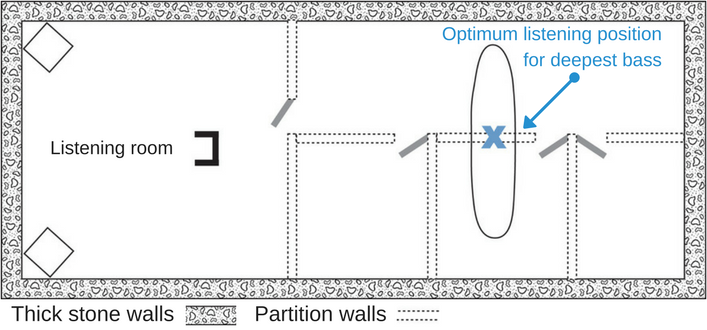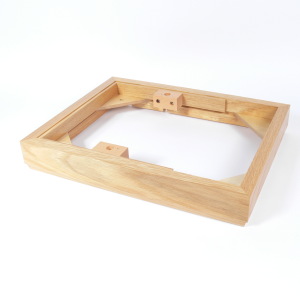
The following originally appeared in Russ's booklet 'Shake, Rattle & Roll' and was updated for his 'Sound Solutions' book. It forms what is essentially a primer in room acoustics for the home audio enthusiast. We emphasise here the home audio enthusiast - this is not written for the professional audio engineer. Professional audio has very specific requirements when it comes to room acoustics and these are not the same as those for the home environment.
One of the key points made in the article is that your system does not sit in isolation within the room but interacts with it. Understanding this is vital to achieving the best and most natural performance from your Hi-Fi...
The factors that have an influence on the sound and your enjoyment of your system include the position and placement of your system and speakers; the size and construction of your room; the way the room and furnishings absorb the sound 'echo' within it and the willingness of your room to 'sing-along' with your system. The emphasis here is to show you what you can do to improve the sound of the room by looking at these factors, finding out where the problems are and then fixing them. You don't have to do any of the structural work yourself, use professionals whenever appropriate.
A Hi-Fi system is not a simple chain with an input (the source) at one end and an output (the loudspeakers) at the other. It is a complex interactive loop with many points of feedback where it interacts with the room, its supports and itself.
Most advice on room acoustics - whether it is a magazine article or textbook - includes maths for calculating room eigentones, reverberation times, absorption coefficients, etc. This sort of technical detail, interesting though it is to the scientifically inquisitive, is not of any practical value in an article like this. From time to time there are also several 'consultants' advertising in Hi-Fi magazines offering and providing 'cures' with special 'room tuning' devices. No amount of this kind of analysis can tell you about the benefits of Blu-Tack™ or identify problems such as four wobbly points of contact, loose driver screws or poor speaker placement. No amount of frequency-tuned absorbers can possibly solve these problems.
1. The room has a sound?
You may have noticed that your system sounds different in different places in the same room and also in different rooms. The effect of the room 'sound' on the sound of a Hi-Fi system is enormous and, in Hi-Fi circles, badly misunderstood. In audio scientific circles it has been researched and measured but not explained.
In 1992, four Canadian scientists presented a paper to the 93rd Convention of the Audio Engineering Society, of which I am a member, on 'The Effect of Loudspeaker Placement on Listening Preference Ratings'. An extract states:
"Room placement of a loudspeaker measurably affects listeners' judgement of its quality, and some changes in positioning are more easily perceived than the substitution of a different loudspeaker. Speaker placement similarly modifies quality judgement of the programme material".
No explanation of these effects was offered but I believe that it is quite obvious. The room and the loudspeaker (plus the rest of the Hi-Fi system) are interactive. Each has profound effects on the other and to understand what is happening in one direction, you have to know what is happening in the other. It is important to appreciate that not only does the loudspeaker feed a signal into the room, but that the room feeds that signal plus the room sound back into the loudspeaker. The loudspeaker acts as a very efficient microphone at the same time as it is working as a loudspeaker!

The problem is rather like that of designing a good car suspension. The suspension exists to even out the road surface imperfections and to allow safe cornering, etc., but its performance is complicated by the car body sitting on top of it. The road is moving one end of the spring and damper, whilst the body is moving the other end - each in response to what the other is doing. Automotive engineers understand this interactive relationship but, bizarrely, most audio engineers do not understand the relationship between a loudspeaker and the room. It is clear that they don't consider the relationship because they continue to design loudspeakers to give an even, flat frequency response (the usual design criterion) under what is called 'free field' conditions. 'Free field' means away from any reflective surface, i.e. up a 20 foot pole in a field!
Since this is a very inconvenient method - rain, snow, wind noise, etc. - the Anechoic chamber was invented as an indoor substitute. Nearly every Hi-Fi loudspeaker is designed and tested this way.
It's as if the car was designed and road tested only on a perfectly smooth, flat, straight road with no hard acceleration, braking or turning involved. You can imagine what would happen to such cars when driven on real roads under real driving conditions - the car would be very hard to control, bouncing all over the place, lurching into and out of corners and dangerously unstable.
Yet this is exactly what we are expected to put up with in a Hi-Fi system when loudspeakers are designed with loose, floppy drive units and complex crossover networks. Tragically, it is the more expensive, larger 'esoteric' loudspeakers that are the worst in this respect. They are designed to give fuller, deeper bass - right in the frequency area where the room has most effect on them.
This isn't meant to be a diatribe against Hi-Fi loudspeakers designers or manufacturers, but an explanation of what is going on when you play a Hi-Fi system in a room. The room / loudspeaker interaction is only one of the problems as you will discover when you read on. My purpose is to help you to recognise the problems and solve them in an inexpensive and effective way.
What influences the sound of a room?
We don't need special test equipment to tell us how good or bad a room is. We have ears and we can tell a lot about a room simply by talking in it.
A trick like snapping the fingers or clapping can be useful for revealing the high frequency echo qualities, but speech is all we need to judge the sound qualities of a room. Those of us able to play or listen to a musical instrument being played in a room will have noticed how few rooms are 'bad' to listen to live instruments in compared with how many are 'bad' to listen to Hi-Fi systems in. That is because an instrument is a true 'source' and interacts very little with the room. You can still hear the room's character, however, on speech or with a live instrument.
That 'character' may be improved to the benefit of both live and reproduced sounds in ways that are inexpensive, effective and aesthetically acceptable.
Room Proportion and Low Frequency Modes
All the books and articles on room acoustics that I have read, whilst being (for the most part) technically correct, make an important but unstated assumption. They talk about room dimensions and the associated room modes, eigentones (room standing wave frequencies defined by the distance between wall, ceiling and floor) and low frequency responses, assuming that all the walls, the floor and the ceiling are totally reflective at all frequencies.
They also assume a totally closed box! Real rooms aren't like this and differ from the theoretical model in a number of very important ways. These differences seriously complicate and confuse the simple model the authors propose. For example: an aperture like a doorway or window in a room creates a Helmholtz Resonator (an acoustical resonator which is sharply resonant at a single frquency); a large picture window, French window or patio door turns the room 'box' model into an open pipe model (basically a 'tube' where the air in the pipe resonates at a frequency equal to the velocity of sound divided by twice the length of the pipe. All the harmonics of that frequency are also present). Each of these have distinct and different acoustic properties.
Real domestic rooms are rarely constructed with all surfaces reflective at low frequencies. Solid brick, stone or concrete external walls are reflective to low frequencies because their mass is high enough, but light stud or partition walls are not. Light partition walls are absorbers of low frequencies because they flex. Low frequencies travel right through them to be reflected off the nearest solid wall.
The low frequencies generated by the loudspeakers in your listening room may, therefore, 'see' only the solid outer walls of your house. These are the dimensions that determine the low frequency eigentones or modes, not the walls you see in the room!
Calculations for the height are similarly misleading because the 'floor' will not be the wooden suspended floor but the concrete raft beneath. The ceiling will also be of too light a construction to form a low frequency reflective surface. Low frequencies may be reflected from the roof rather than the apparent ceiling. The room you see is not necessarily the room that your loudspeakers 'see'. The lowest frequencies in the music may only be heard properly outside the room.
It is obvious, therefore, that only actual measurements can be relied upon and calculations from textbook formulae can be misleading.

Diagram 5.1 My room layout






















